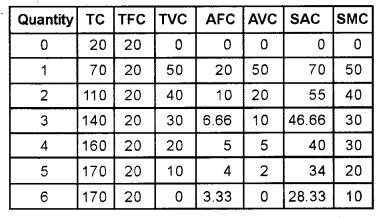Kerala Plus Two Microeconomics Chapter Wise Previous Questions Chapter 3 Production and Costs
Question 1.
Classify the following costs into Fixed Costs and Variable costs. (MARCH-2008)
Raw material costs, Daily wages, Interest on capital, Rent, Salary to M.D, Electricity charges, Insurance, Transportation Charges.
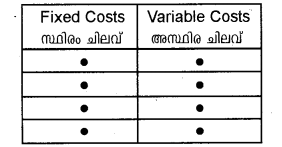
Answer:
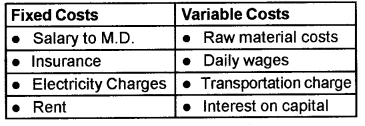
Question 2.
Following table shows the AC and total quantity of a firm. (MARCH-2008)

a) Complete the table.
b) Plot TFC, TVC and TC on the same set of axis.
c) Write relevant equations to find out AFC, AVC, AC and MC.
Answer:
a)


Question 3.
The cost incurred by a Toys Manufacturing Company is given below. Classify the cost into fixed cost and variable cost. (MARCH-2009)
Rent, Wages, Insurance Premium, Electricity Charges, Cost of raw material, Salary to the Managing Director.
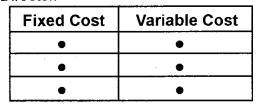
Answer:

Question 4.
The total cost structure of a firm is given in the schedule (MARCH-2009)

a) Fill up the column appropriately from the data given.
b) On the same set of axis plot the AC and MC curves.
Answer:

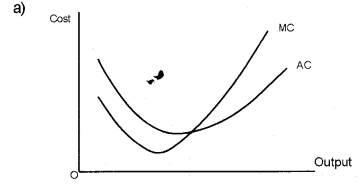
Question 5.
Total cost of producing 1000 cell phone is ₹10 lakhs if the marginal cost of producing 1001 unit is ₹4,000. What will be the total cost of producing 1001 unit? (JUNE-2009)
Answer:
10,04,000
Question 6.
State whether the following statements are true or false. Rewrite the statement if they are false: (JUNE-2009)
a) TFC is zero at zero level of output.
b) AC is minimum at the point where AC = MC.
c) AVC curve is a rectangular hyperbola.
d) TFC curve is‘U’shaped.
Answer:
a) False. TFC is positive even when the level of output is zero.
b) True
c) False. AVC curve is‘U’ shaped.
d) False. TFC is horizontal straight line.
Question 7.
Reserve Bank of India has increased the bank rate and cash reserve ratio in, June 2008 to control inflationary tendencies in the Indian economy. How ever this effort of RBI became ineffective (JUNE-2009)
Answer:
a) Value of certain products went up and the petroleum prices increased. As a result of it RBI’s efforts to regulate the inflationary pressure failed. Thus monetary policy resulted ineffective.
b) In additional to monetary measures like CRR and bank rate policy, various other measures can be adopted to regulate the economy. Taxation and expenditure policy can be used by the government. Similarly government may provide subsidy or can introduce price ceiling and support prices.
Question 8.
Let the production function of a firm be Q = 3L2K2 (MAY-2010)
a) Find out the maximum possible output that the firm can produce with 5 units of L and 3 units of K.
b) What is the maximum possible output that the firm can produce with 10 units of L and zero units of K?
Answer:

Question 9.
“In the long run, the shut down point of the firm is the minimum of LRAC curve.” (MAY-2010)
a) Which is the shut down point of a perfect competitive firm in short run?
b) Draw the diagram to explain the shut down condition of a firm under short run.
Answer:
a) Previously, while deriving the supply curve, we have discussed that in the short run the firm continues to produce as long as the price remains greater than or equal to the minimum of AVC. Therefore, along the down, the last price-output combination at which the firm produces positive output is the point of minimum AVC where the SMC curve cuts the AVC curve. Below this there will be no production. This point is called tiTe short run shutdown point of the firm. In the long run, however, the shut down point is the minimum of LRAC curve.
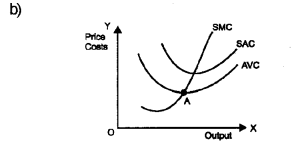
Question 10.
Correct the figure if there are any mistakes (MARCH-2011)
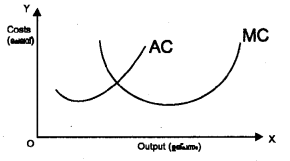
Answer:

Question 11.
Gireesh cultivates paddy on a piece of land. He employs labourers successively and total product is given here. (MARCH-2011)
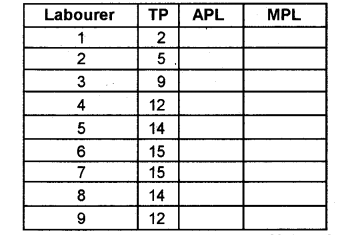
a) Complete the given table.
b) Plot TP, APL and MPL on the same set of axis.
c) At what level of total product, the producer stops further employment? (Suggest from schedule)
d) Give reasons.
Answer:
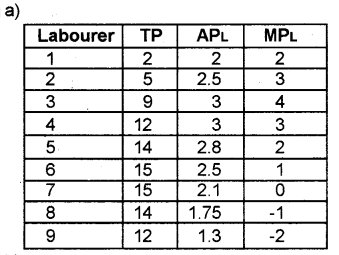
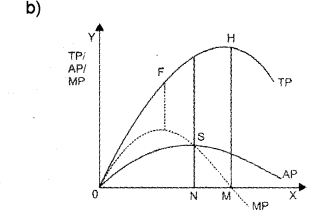
c) 7th labour
d) When 7th labour is employed, TP becomes maximum or MP becomes zero.
Question 12.
The following table shows the TC schedule of a firm. What is the TFC of this firm? Calculate TVC, AFC, AVC, SAC and SMC of the firm. (MARCH-2012)
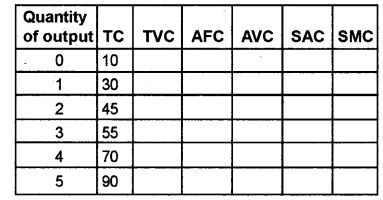
Answer:

Question 13.
Rajeev is a farmer who produces paddy in his 10 acres of land. He is trying to increase his total output by increasing the quantity of only one of his inputs – say labour. Which law of production explains this situation? What will be the effect on his total output? Give your suggestion to Rajeev with a suitable diagram. (MARCH-2012)
Answer:
Law of Variable Proportions The law of diminishing marginal product says that if we keep increasing the employment of an input, with other inputs fixed, eventually a point will be reached after which the resulting addition to output will start falling. A somewhat related concept with the law of diminishing marginal products is the law of variable proportions. It says that the marginal product of a factor input initially rises with its employment level. But after reaching a certain level of employment, it starts falling.
The reason behind the law of diminishing returns or the law of variable proportion is the following. As we hold one factor input fixed and keep increasing the other, the factor proportions change. Initially, as we increase the amount of the variable input, the factor proportions become more and more suitable for the production and marginal product increases. But after a certain level of employment, the production process becomes too crowded with the variable input and the factor proportions become less and less suitable for the production. It is from this point that the marginal product of the variable input starts falling. Since inputs cannot take negative values, marginal product is undefined at zero level of input employment. Marginal products are additions to total product. For any level of employment of an input, the sum of marginal products of every unit of that input up to that level gives the total product of that input at that employment level. Therefore, total product is the sum of marginal products. Average product of an input at any level of employment is the average of ail marginal products up to that level. Average and marginal products are often referred to as average and marginal returns, respectively, to the variable input.
The marginal product (MP) and total product (TP) of an input are related. The points of relationship are given below.
i) When MP increases, TP also increases
ii) When MP is zero, TP becomes maximum
iii) When MP becomes negative, TP turns negative The relationship between MP and TP are picturised below
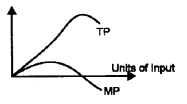
Question 14.
The following table shows TFC and TVC of a firm. Find out TC, AFC, AVC, AC and MC of the firm. (MARCH-2013)
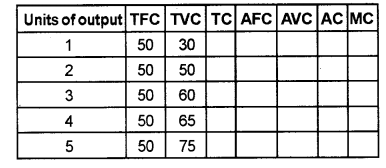
Answer:

Question 15.
From the table identify the different levels of TP which makes the different phases of the operation of the law of variable proportions. (MARCH-2013)

Answer:
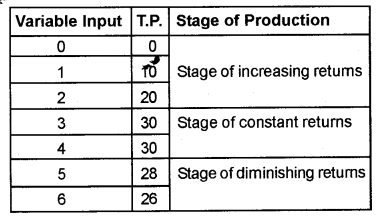
Question 16.
Short run MC and AC curves are U-shaped. Write down any three relationships between Me and AC. (MAY-2014)
Answer:

marginal cost (MC) is above average cost (AC), the average cost rises, that is, the marginal cost (MC) pulls the average cost (AC) upwards.
ii) When marginal cost (MC) stands equal to the average cost (AC), the average cost remains the same, that is, the marginal cost pulls the average cost horizontally.
iii) if the marginal cost (MC) is below the average cost (AC); average cost falls, that is, the marginal cost pulls the average cost downwards.
Question 17.
‘Short run production functions are fixed proportion production functions’. Do you agree? Substantiate (MAY-2014)
Answer:
Yes, I agree with the statement that Short Run Production Functions are fixed proportion production functions. The short run is a time period where at least one factor of production is in fixed supply. A business has Ghosen it’s scale of production and must stick with this in the short run.
We assume that the quantity of plant and machinery is fixed and that production can be altered by changing variable inputs such as labour, raw materials and energy.
The time periods used differ from one industry to another; for example, the short-run in the electricity generation industry differs from local sandwich bars. If you are starting out in business with a new venture selling sandwiches and coffees to office workers, how long is your long run? It could be as short as a few days – enough time to lease a new van and a sandwich-making machine
Question 18.
Fill in the blanks: (MAY-2014)

Answer:
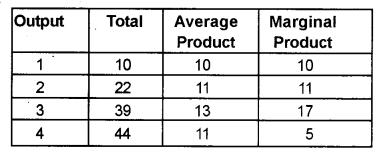
Question 19.
Which of the following cost will be zero when production is stopped? (MARCH-2015)
a) Average Fixed cost
b) Total Cost
c) Fixed cost
d) Variable cost
Answer:
d) variable cost
Question 20.
The following diagram represents TP, MP and AP curves of a firm. After studying the curves, answer the questions given below. (MARCH-2015)

a) When does ‘TP’ becomes maximum?
b) At what rate (increasing or decreasing) does ‘TP’ increase when ‘MP’ increases?
c) When does ‘MP’ become negative?
Answer:
a) MP becomes zero
b) Increasing rate
c) TP decreases
Question 21.
Following information about a firm is given below: (MARCH-2015)

From the given information estimate,
a) Total Fixed Cost
b) Total Variable Cost
c) Average cost
d) Marginal Cost
Answer:

Question 22.
Consider the following cost schedule of a firm and find AC, AVC and MC. (MAY-2015)

Answer:
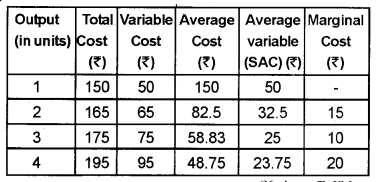
Question 23.
“Production is the transformation of inputs into outputs”. Justify the statement by citing examples from your location. Also built a production function based on your example. (MAY-2015)
Answer:
Production is possible only through effective utilisation of factors of production. The factors of production like land, labour, capital and organisation are called inputs. In the production process, these inputs. In the production process, these inputs are transformed into output. Thus a production function stands for functional relationship between inputs and output.
In my locality paddy is produced by combining inputs like labour, machinery, land, bank loan and organisers efforts. These are inputs. Thus the paddy production function can be stated as follows.
Q = f(X1, X2, X3 ,Xn)
Where Q = paddy, X1, X2 ……… Xn are inputs used.
Question 24.
i) There is an error in the diagram. Redraw the diagram by correcting the same (MARCH-2016)
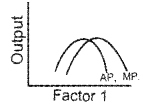
ii) Explain the relationship between Average Product (AP) & Marginal Product (MP)
Answer:
i)
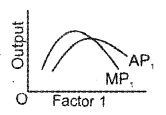
ii) a) When MP is greater than AP, AP rises.
b) When MP is less than AP, AP falls.
c) When MP = AP, AP is at its maximum.
Question 25.
The relationship between input & Output is ______ (MARCH-2016)
Answer:
Production function
Question 26.
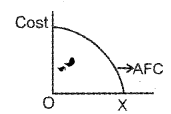
Draw the diagram correctly (MARCH-2016)
(AFC – Average Fixed Costs)
Answer:

Question 27.
![]() is _____ (MARCH-2016)
is _____ (MARCH-2016)
а) MC
b) AC
c) FC
d) VC
[TC = Total Cost, q = Output, MC = Marginal Cost, AC = Average Cost, FC = Fixed Cost, VC = Variable Cost]
Answer:
a) MC
Question 28.
State and explain the ‘law of variable proportions’ (MAY-2016)
Answer:
When more and more units of a variable input are added with the fixed input, the marginal product would increase only upto a certain point. Thereafter, the marginal product declines. This phenomenon is known as the Law of Variable Proportions. It is also known as returns to a factor.
The shape of TP, AP and MP suggests that they are specifically passing through three phases.
They are:
First phase : In the first stage, both AP and MP increase. As a result TP also increases at an in-creasing rate. This stage is known as the stage of increasing return to a factor. AP reaches the maximum level in this stage.
Second phase : Both AP and MP decrease at this stage. The TP increases at a decreasing rate. More importantly, TP reaches maximum and MP touches zero. This stage is also known as the stage of diminishing returns to a factor.
Third phase : At this stage, the MP becomes negative. As a result, TP also starts declining. The decline of AP is continuous. In the graph, when TP reaches maximum and MP touches zero. When MP becomes negative, TP starts declining. This stage is known as the stage of negative returns to a factor.
Question 29.
The cost curve which is a rectangular hyperbola is (MAY-2016)
a) ATC
b) AFC
c) TFC
d) AVC
Answer:
b) AFC
Question 30.
Short run marginal cost curve cuts average variable cost curve from below at the (MAY-2016)
a) the minimum point of AVC
b) any point of AVC
c) the falling portion of AVC
d) the rising portion of AVC
Answer:
a) the minimum point of AVC
Question 31.
Match the following: (MARCH-2017)

Answer:

Question 32.
Rising portion of long run marginal cost curve from the minimum of long run average cost curve is known as (MARCH-2017)
a) Long run supply curve of the firm.
b) Long run demand curve of the firm.
c) Variable cost curve of the firm.
d) Fixed cost curve of the firm.
Answer:
Long run supply curve of the firm.
Question 33.
The following table shows the total cost schedule of a firm. Calculate TVC, AFC, AVC, SAC and SMC schedules. (MARCH-2017)
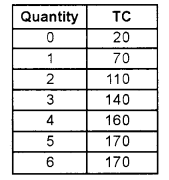
TVC = Total Variable Cost, AFC = Average Fixed Cost, AVC = Average Variable Cost, SAC = Short run Average Cost, SMC = Short run Marginal cost)
Answer:

